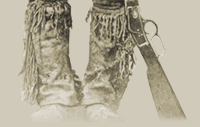 |

[ Project Plans | Essential
Questions | Knowledge Hunt | Glossary | Links ]
Do the Mounties Always Get Their Man?
An Examination of the Mounties as an Enduring Symbol of Canadian
Hardiness and Persistence
Introduction
Students need to understand the great difficulty involved in settling
the Canadian West. The coming together of numerous cultures, the
great distances, and providing safety for new Canadian settlers
was of paramount importance, not to mention making sure the area
was properly claimed before the United States could assert their
authority in the area. What do the Mounties represent to Canadians?
What do they represent to the world? Why have they become such an
important symbol of Canadian pride? Were the Mounties worthy of
becoming this great Canadian icon? Did they live up to and truly
epitomize that image?
Project Explanation
In this project, students will develop an appreciation of the problems
and difficulties associated with enforcing the law and keeping the
peace in the Canadian West. The Mounties represent Canada around
the world, as seen recently during the outpouring of grief for the
four slain RCMP officers in Alberta, and students will examine what
they symbolize to Canadians and to other cultures. They will examine
the life, stories, personalities, qualities, and traits of both
the Maverick Mounties and the forces that they were a part of, evaluating
whether or not the reputation was justly deserved.
Alberta Social Studies Curriculum Unit Connections
Grade Four - Alberta: The Land, Histories and Stories
4.2 The Stories, Histories and People of Alberta
Grade Five - Canada: The Land, Histories and Stories
5.2 Histories and Stories of Ways of Life in Canada
5.3 Canada: Shaping an Identify
Grade Seven - Canada: Origins, Histories and Movement of People
7.2 Following Confederation: Canadian Expansions
Materials and Resources Needed
Procedures
When introducing this project, begin by having students brainstorm
to identify some of the symbols they know represent something. Symbols
may include flags and coat of arms, animals, birds, trees, or other
things from the natural environment; historical events and heroes;
inventions or predominant technologies; and traditional holidays
or festivals. Have the students identify various national, provincial,
and regional symbols. For example:
Canada - maple leaf, beaver, flag, hockey
Alberta – wild rose, mountains and prairie, oil
Calgary – white cowboy hats, Stampede
Christians – cross
Teachers - apple
What feelings or thoughts do these symbols convey? Why do they
represent that group of people?
The Sam Steel Historical Minute discusses the reputation of the
Mounties at the time, and will help the students begin to understand
what their life would have been like. The federal government was
worried it would lose the West, as many American politicians called
for a military takeover of the area. The Mounties were also needed
to keep the peace between the First Nations people, the settlers
and ranchers, and the American whisky traders. The Mounties earned
a reputation for being tough but fair, and created law and order
in the West. They were respected by First Nations leaders, which
helped to avoid the violence that took place in the U.S. between
the First Nations, settlers, and the army.
Students will now examine the life of the Mountie Mavericks in
the Mavericks: An Incorrigible History of Alberta site. They
will research the life, accomplishments, stories, personalities,
qualities and personal traits of one the individuals or of the forces
as a group. Through this, they will examine how each of the Mavericks
live up to the image of the Mounties, and how they may fall short
of that reputation. Were they perfect, or were they human beings
who had flaws? Why or why not?
The results could then be compared to the stereotypes of the Mounties,
or even of Canadians in general, as non-Canadians see them, or as
they have been portrayed in the media. There have been hundreds
of books about the Mounties, television shows like Due South,
cartoons such as Dudley Do-Right, and many movies such as
the Disney version of Dudley Do-Right with Brendan Fraser.
Are there Canadian stereotypes that come from the Mounties? Do
they still truly represent us as Canadians? What stereotypes of
the Mounties or of Canadians do we see in many of these non-Canadian
portrayals of our country? Are these accurate stereotypes or are
they exaggerated?
Assessment and Evaluation
- Students and their teacher should develop their own rubric by
identifying evaluation criteria for the project that will match
their own learner outcomes. This allows students to understand
the expectations for their work and to have input into the ongoing
evaluation process.
- Students may use the project rubric as a guide for writing a
self-assessment of their project work. They will determine their
level for each of the categories and use the criteria specified
in their rubric to justify them.
- After completing the project, students may talk or journal about
what they felt they did very positively, what they had difficulty
with, and how they would change how they would approach a similar
project in the future.
Ideas for Enriching this Project
- Students may brainstorm, design and develop a new symbol that
could represent the RCMP, the NWMP, one of the Mavericks, or even
for the province of Alberta. They could design a flag, a stamp,
a crest, or another type of symbols to represent the Mounties,
now after the slaying of the four Alberta constables. Students
will then write about why they chose that symbol and how it accurately
represents their subject.
- Students could research the actual RCMP flag, crest, uniform,
or history and present their findings to their classmates.
 |



![]()
